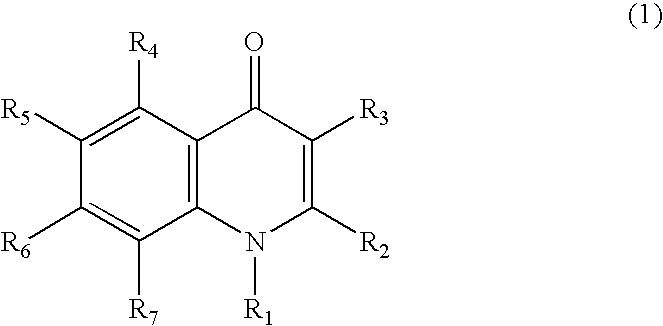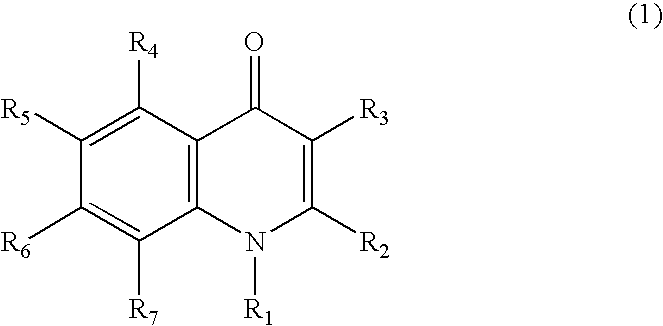Quinolone compound and pharmaceutical composition
a technology of quinolone compound and composition, which is applied in the field of quinolone compound and pharmaceutical composition, can solve the problems of reducing the efficacy of long-term administration, recurrence of movement disorders such as dyskinesia and daily fluctuation, and no fundamental cure for parkinson's disease and other neurodegenerative diseases, so as to improve mitochondrial functional activity and be effective in treatment and prevention.
- Summary
- Abstract
- Description
- Claims
- Application Information
AI Technical Summary
Benefits of technology
Problems solved by technology
Method used
Image
Examples
reference example 1
N-Cyclohexyl-4-fluoro-2-nitro-N-methylaniline
[0249]Potassium carbonate (6.0 g, 43.5 mmol) and N-methylcyclohexylamine (4.6 g, 40.6 mmol) were added to a N-methylpyrolidone (NMP) solution (20 ml) of 2,5-difluoronitrobenzene (5.0 g, 31.4 mmol), and stirred at 100° C. for 3 hours. The reaction mixture was cooled to room temperature, water was added, and the resulting mixture was extracted with ethyl acetate. The organic layer was washed with water, and then dried over anhydrous magnesium sulfate. The resulting dry product was concentrated under reduced pressure to thereby obtain 7.0 g of oily yellow N-cyclohexyl-4-fluoro-2-nitro-N-methylaniline (yield: 89%).
[0250]1H-NMR (CDCl3) dppm:
[0251]1.12-1.80 (10H, m), 2.67 (3H, s), 3.00-3.09 (1H, m), 7.07-7.20 (2H, m), 7.42-7.47 (1H, m)
[0252]The compounds of the following Reference Examples 2 to 5 were prepared in the same manner as in the above Reference Example 1, using corresponding starting materials.
reference example 2
4-Fluoro-N-(2-methoxyethyl)-N-methyl-2-nitroaniline
[0253]1H-NMR (CDCl3) dppm:
[0254]2.85 (3H, s), 3.25-3.31 (5H, m), 3.52 (2H, t, J=5.6 Hz), 7.16-7.20 (2H, m), 7.43-7.47 (1H, m)
reference example 3
4-Fluoro-N-isobutyl-N-methyl-2-nitroaniline
[0255]1H-NMR (CDCl3) dppm:
[0256]0.89 (3H, s), 0.91 (3H, s), 1.89-1.98 (1H, m), 2.81 (3H, s), 2.92 (2H, d, J=7.5 Hz), 7.15-7.20 (2H, m), 7.42-7.46 (1H, m)
PUM
| Property | Measurement | Unit |
|---|---|---|
| temperature | aaaaa | aaaaa |
| temperature | aaaaa | aaaaa |
| temperature | aaaaa | aaaaa |
Abstract
Description
Claims
Application Information
 Login to View More
Login to View More - R&D
- Intellectual Property
- Life Sciences
- Materials
- Tech Scout
- Unparalleled Data Quality
- Higher Quality Content
- 60% Fewer Hallucinations
Browse by: Latest US Patents, China's latest patents, Technical Efficacy Thesaurus, Application Domain, Technology Topic, Popular Technical Reports.
© 2025 PatSnap. All rights reserved.Legal|Privacy policy|Modern Slavery Act Transparency Statement|Sitemap|About US| Contact US: help@patsnap.com



